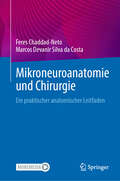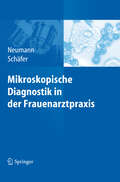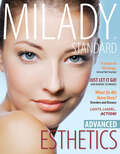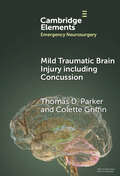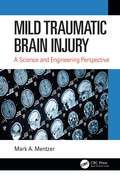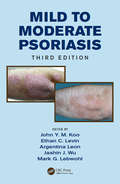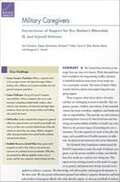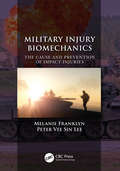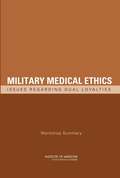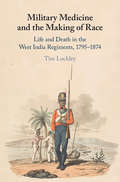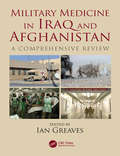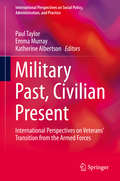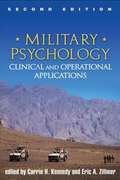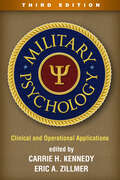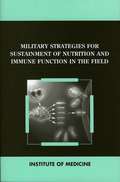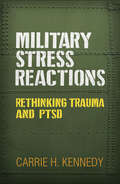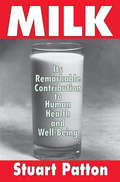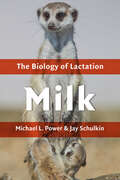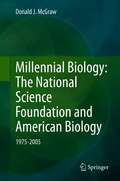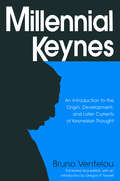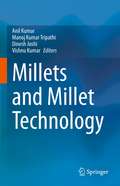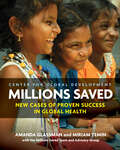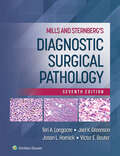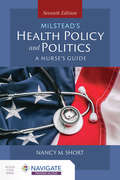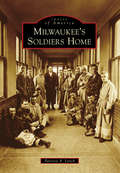- Table View
- List View
Mikroneuroanatomie und Chirurgie: Ein praktischer anatomischer Leitfaden
by Feres Chaddad-Neto Marcos Devanir Silva da CostaDie Mikroneuroanatomie ist für das Verständnis des Gehirns unerlässlich. Die Vermittlung von neuroanatomischen Kenntnissen ist in vielen Fällen eine schwierige Aufgabe, was jedoch vor allem an denjenigen liegt, die dieses Wissen in Kursen, Vorlesungen oder in Büchern vermitteln sollen.In Wirklichkeit ist die Neuroanatomie einfach und muss als Hilfsmittel für die Annäherung an die verschiedenen Bereiche des Gehirns und nicht als Hindernis verstanden werden. Die einzige Möglichkeit, dieses Problem zu überwinden, besteht darin, die Neuroanatomie mit verschiedenen Krankheitstypen in Beziehung zu setzen (arteriovenöse Fehlbildungen, Aneurysmen, Tumore, Kavernome, Hydrocephalus usw.).Dieses Buch bietet einen neuen Ansatz für die Beziehung zwischen Mikroneuroanatomie und Hirnerkrankungen. Jedes Kapitel befasst sich mit einer bestimmten neuroanatomischen Region und setzt alle wichtigen neuroanatomischen Aspekte mit den Krankheiten, die diese Region betreffen, in Beziehung. Außerdem bietet jedes Kapitel detaillierte Einblicke in die sichere Durchführung von hirnchirurgischen Eingriffen in der jeweiligen Region.
Mikroskopische Diagnostik in der Frauenarztpraxis
by Axel Schäfer Gerd NeumannDie lichtmikroskopische Untersuchung von Abstrichpräparaten ist ein kostengünstiges und aussagekräftiges Diagnoseverfahren bei Vaginalinfektionen. Viele Erreger sind schnell und sicher zu identifizieren, so dass therapeutische Maßnahmen oder weiterführende Diagnostik folgen können. Der Band bietet Praxiswissen zur Abstrichentnahme, zur Herstellung von Nativpräparaten, zu Färbemethoden und mikroskopischer Technik. Exzellente Farbabbildungen helfen bei der Interpretation der Präparate. Alle relevanten Krankheitsbilder werden von Experten erläutert.
Milady Standard Esthetics: Advanced
by Mark Lees Sallie Deitz Anne Miller Pamela Hill Melanie Sachs Milady® Efrain Arroyave Anne Beauchamp Linda Bertaut Helen Bickmore Judith Culp Michelle D’Allaird Janet M. D’Angelo Ramona Moody French Natalia Michalun M. Varinia Michalun Peter T. Pugliese Cynthia Shaw Laura Todd David Vidra Kris La ChanceMILADY STANDARD ESTHETICS: ADVANCED, SECOND EDITION is an essential tool for students enrolled in advanced esthetics programs and critical for anyone serious about achieving a higher level of success in the beauty and wellness field. <p><p>This new edition demonstrates Milady's commitment to providing the most current, cutting-edge educational resources to esthetic students and professionals anxious to expand and perfect their skills in one of the fastest growing industries of the day. It responds to the increasing demand for a more robust knowledge of skin care principles and techniques resulting from trends in medical esthetics as well as in hospitality and tourism. MILADY STANDARD ESTHETICS: ADVANCED encompasses the broad areas of advanced skin sciences, including skin disorders and the updated ABC's of skin cancer; advanced esthetic techniques and devices; spa and alternative therapies; and working in a medical setting, including plastic surgery procedures and pre- and post-medical treatments. An introductory section addresses changes in esthetics to keep the student up-to-date on the newest technology and products, plus the final two chapters delve into financial business and marketing skills vital for rounding out success in the world of esthetics.
Mild Traumatic Brain Injury including Concussion (Elements in Emergency Neurosurgery)
by Thomas D. Parker Colette GriffinMost traumatic brain injury (TBI) cases are considered mild. Precise definitions vary, but typically, loss of consciousness and post-traumatic amnesia duration is brief (e.g. <30 minutes and <24 hours respectively), and standard imaging is normal. Prognosis in mild TBI is generally good, but disabling persistent symptoms such as headaches, dizziness, affective and cognitive issues are common. A focussed assessment tailored to each individual symptom is crucial for management. Advanced MRI and blood-based biomarkers of mild TBI are emerging and are likely to play an increasingly important role in the assessment of patients following a head injury.
Mild Traumatic Brain Injury: A Science and Engineering Perspective
by Mark A. MentzerMild traumatic brain injury (mTBI), directly related to chronic traumatic encephalopathy, presents a crisis in contact sports, the military, and public health. Mild Traumatic Brain Injury: A Science and Engineering Perspective reviews current understanding of mTBI, methods of diagnosis, treatment, policy concerns, and emerging technologies. It details the neurophysiology and epidemiology of brain injuries by presenting disease models and descriptions of nucleating events, characterizes sensors, imagers, and related diagnostic measures used for evaluating and identifying brain injuries, and relates emerging bioinformatics analysis with mTBI markers. The book goes on to discuss issues with sports medicine and military issues; covers therapeutic strategies, surgeries, and future developments; and finally addresses drug trials and candidates for therapy. The broad coverage and accessible discussions will appeal to professionals in diverse fields related to mTBI, students of neurology, medicine, and biology, as well as policy makers and lay persons interested in this hot topic. Features Summarizes the entire scope of the field of mTBI Details the neurophysiology, epidemiology, and presents disease models and descriptions of nucleating events Characterizes sensors, imagers, and related diagnostic measures and relates emerging bioinformatics analysis with mTBI markers Discusses issues with sports medicine and military issues Covers therapeutic strategies, surgeries, and future developments and addresses drug trials and candidates Dr Mark Mentzer earned his PhD in Electrical Engineering from the University of Delaware. He is a former research scientist at the US Army Research Laboratory where he studied mild traumatic brain injury and developed early-detection brain injury helmet sensors. He is a certified test director and contracting officer representative. He possesses two Level-III Defense Acquisition University Certifications in Science and Technology Management and in Test and Evaluation. During his career, he developed a wide range of sensors and instrumentation as well as biochemical processes to assess brain trauma. Mentzer currently teaches graduate systems engineering and computer science courses at the University of Maryland University College.
Mild to Moderate Psoriasis
by John Koo Mark Lebwohl Argentina Leon Ethan Levin Jashin WuUsing a practical and problem-focused approach, this updated, full-color Third Edition of Mild-to-Moderate Psoriasis equips dermatologists, internists, family practitioners, and residents with a state-of-the-art guide to the clinical management of mild-to-moderate psoriasis.Written by an international team of key opinion leaders, this resource explores new developments in treatments for the condition and provides clinicians with up-to-date strategies for optimal patient management.
Military Caregivers: Cornerstones of Support for Our Nation's Wounded, Ill, and Injured Veterans
by Margaret C. Harrell Terri Tanielian Rajeev Ramchand Michael P. Fisher Carra S. Sims Racine HarrisMilitary caregivers are an essential part of our nation's ability to care for returning wounded warriors. Far too often, their own needs are neglected. The RAND Corporation and the Elizabeth Dole Foundation lay the groundwork to inform policy and program development relative to the needs of military caregivers that often differ from the needs of the general caregiving population.
Military Injury Biomechanics: The Cause and Prevention of Impact Injuries
by Melanie Franklyn Peter Vee LeeMilitary Injury Biomechanics: The Cause and Prevention of Impact Injuries is a reference manual where information and data from a large number of sources, focussing on injuries related to military events, has been critically reviewed and discussed. The book covers the cause and prevention of impact injuries to all the major body regions, while topics such as the historical background of military impact biomechanics, the history and use of anthropomorphic test devices for military applications and the medical management of injuries are also discussed. An international team of experts have been brought together to examine and review the topics. The book is intended for researchers, postgraduate students and others working or studying defence and impact injuries.
Military Medical Ethics: Issues Regarding Dual Loyalties
by Institute of Medicine of the National AcademiesDual loyalties exist in many medical fields, from occupational health to public health. Military health professionals, as all health professionals, are ethically responsible for their patients' well-being. In some situations, however, military health professionals can face unique ethical tensions between responsibilities to individual patients and responsibilities to military operations. This book summarizes the one-day workshop, Military Medical Ethics: Issues Regarding Dual Loyalties, which brought together academic, military, human rights, and health professionals to discuss these ethical challenges. The workshop examined two case studies: decisions regarding returning a servicemember to duty after a closed head injury, and decisions on actions by health professionals regarding a hunger strike by detainees. The workshop also addressed the need for improvements in medical ethics training and outlined steps for organizations to take in supporting better ethical awareness and use of ethical standards.
Military Medicine and the Making of Race: Life and Death in the West India Regiments, 1795–1874
by Tim LockleyThis book demonstrates how Britain's black soldiers helped shape attitudes towards race throughout the nineteenth century. The West India Regiments were part of the British military establishment for 132 years, generating vast records with details about every one of their 100,000+ recruits which made them the best-documented group of black men in the Atlantic World. Tim Lockley shows how, in the late eighteenth century, surgeons established in medical literature that white and black bodies were radically different, forging a notion of the 'superhuman' black soldier able to undertake physical challenges far beyond white soldiers. By the late 1830s, however, military statisticians would contest these ideas and highlight the vulnerabilities of black soldiers instead. The popularity and pervasiveness of these publications spread far beyond British military or medical circles and had a significant international impact, particularly in the US, both reflecting and reinforcing changing notions about blackness.
Military Medicine in Iraq and Afghanistan: A Comprehensive Review
by Ian GreavesMany, if not most, of the recent improvements in trauma care in civilian practice have developed from military experience. The British Defence Medical Services have been recognised as providers of exemplary health care. Although there will is an emphasis on trauma, this book also captures lessons from internal medicine and infectious disease, ethics (for example dealing with detainees – a particularly controversial subject), human factors, mental health issues and rehabilitation. <P><P>Military Medicine provides the evidence and context for these innovations, and its unique and important account will be of interest to both military and civilian practitioners alike.
Military Past, Civilian Present: International Perspectives on Veterans' Transition from the Armed Forces (International Perspectives on Social Policy, Administration, and Practice)
by Paul Taylor Emma Murray Katherine AlbertsonThis edited book presents a synthesis of current international knowledge on the topic of military veteran transition to civilian life. Understanding the transition of individuals from military institutions to civilian life is of great importance. The essential elements of transition support are currently widely debated in order to assess current practice and potential shortcomings in the intention to improve health, welfare and social outcomes for military veterans. This text links original research and critical commentary to public policy and practice in the area of veteran transition. Doing so through a collection of international perspectives assists in locating continuity and difference between strategies, agendas and the realities of what is actually known of the veteran’s experience. Chapters in this text examine the subject of transition along lines of enquiry that focus in on themes such as social justice, veteran identity and developments in transition agendas. Globally, many veterans face complex social issues such as low income, barriers to employment, and problems of health and welfare. Chapters take stock of the real-world issues affecting veterans and at the same time casts a critical eye over the limitations in accessing, or denial of access to opportunities, support and remedy. The veteran identity is an important dimension of enquiry here. This book looks at the relational factors between the veteran and the public, the creation of a master status and the challenges faced by veterans in transitioning into a cultural context that is saturated with imagery of what a veteran ‘is’. Chapters also seek to pose recommendations as to how the policy and practice agenda that surrounds veterans and the bridging of the gap between military and civilian life may be developed. Here authors point towards the value of knowledge, research and analysis that is underpinned by participatory strategies with veterans themselves. For example, seeking to establish lines of enquiry that value the voice of veterans as an ongoing and iterative dimension of developing understanding.
Military Psychology, Second Edition
by Eric A. Zillmer Carrie KennedyWidely regarded as the authoritative reference in the field, this book comprehensively explores the psychological needs of today's service members and how to meet them effectively. Expert contributors review best practices for conducting fitness-for-duty evaluations and other types of assessments, treating frequently encountered clinical problems, responding to disasters, and promoting the health and well-being of all personnel. The book also examines the role of mental health professionals in enhancing operational readiness, with chapters on crisis and hostage negotiation, understanding terrorists, and more. New to This Edition The latest scientific knowledge, clinical interventions, and training recommendations. Chapter on acute combat stress. Chapter on post-deployment problems, including PTSD and depression. Chapter on military psychology ethics. Coverage of blast concussion screening and evaluation.
Military Psychology, Third Edition: Clinical and Operational Applications
by Carrie H. Kennedy and Eric A. ZillmerWith more than 60% new material reflecting advances in evidence-based treatments and the evolving roles of military mental health providers, the authoritative resource in the field is now in a significantly revised third edition. The volume provides research-based roadmaps for prevention and intervention with service members and veterans in a wide range of settings. Up-to-date information about military procedures and guidelines is included throughout. Grounded in current knowledge about stress and resilience, chapters describe best practices in treating such challenges as depression, anxiety disorders, posttraumatic stress disorder, and substance use disorders. Also addressed are operational functions of psychologists in personnel assessment and selection, counterintelligence, and other areas. New to This Edition *Chapters on new topics: the spectrum of military stress reactions, concussion management, military sexual assault, embedded/expeditionary psychological practice, and security clearance evaluations. *Fully rewritten chapters on evidence-based treatments, behavioral health in primary care, and disaster mental health. *Incorporates major shifts in how and where military mental health services are delivered.
Military Strategies for Sustainment of Nutrition and Immune Function in the Field
by Institute of MedicineEvery aspect of immune function and host defense is dependent upon a proper supply and balance of nutrients. Severe malnutrition can cause significant alteration in immune response, but even subclinical deficits may be associated with an impaired immune response, and an increased risk of infection. Infectious diseases have accounted for more off-duty days during major wars than combat wounds or nonbattle injuries. Combined stressors may reduce the normal ability of soldiers to resist pathogens, increase their susceptibility to biological warfare agents, and reduce the effectiveness of vaccines intended to protect them. There is also a concern with the inappropriate use of dietary supplements.This book, one of a series, examines the impact of various types of stressors and the role of specific dietary nutrients in maintaining immune function of military personnel in the field. It reviews the impact of compromised nutrition status on immune function; the interaction of health, exercise, and stress (both physical and psychological) in immune function; and the role of nutritional supplements and newer biotechnology methods reported to enhance immune function.The first part of the book contains the committee's workshop summary and evaluation of ongoing research by Army scientists on immune status in special forces troops, responses to the Army's questions, conclusions, and recommendations. The rest of the book contains papers contributed by workshop speakers, grouped under such broad topics as an introduction to what is known about immune function, the assessment of immune function, the effect of nutrition, and the relation between the many and varied stresses encountered by military personnel and their effect on health.
Military Stress Reactions: Rethinking Trauma and PTSD
by Carrie H. KennedyMany people--including some mental health professionals and service members themselves--have the misconception that military deployment is highly likely to cause posttraumatic stress disorder (PTSD). This book gives practitioners a more nuanced understanding of military stress reactions and related mental health concerns, from transient adjustment problems to clinical disorders. Drawing on expert knowledge of military environments and culture, Carrie H. Kennedy provides vital guidance for evidence-based assessment, intervention, and prevention. Kennedy emphasizes that overdependence on the diagnosis of PTSD can lead to suboptimal care, and shows how to tailor treatment to each service member's or veteran's needs. A crucial addition to any practitioner's library, the book is illustrated with numerous case vignettes.
Milk: Its Remarkable Contribution to Human Health and Well-being
by Stuart PattonMilk is the one food that sustains life and promotes growth in all newborn mammals, including the human infant. By its very nature, milk is nutritious. Despite this, it has received surprisingly little attention from those interested in the cultural impact of food. In this fascinating volume, Stuart Patton convincingly argues that milk has become of such importance and has so many health and cultural implications that everyone should have a basic understanding of it. This book provides this much-needed introduction. Patton's approach to his subject is comprehensive. He begins with how milk is made in the lactating cell, and proceeds to the basics of cheese making and ice cream manufacture. He also gives extensive consideration to human milk, including breasts, lactation, and infant feeding. Pro and con arguments about the healthfulness of cows' milk are discussed at length and with documentation. Patton explores the growing gap between the public's impressions of milk, and known facts about milk and dairy foods. He argues that the layperson's understanding of milk has deteriorated as a result of propaganda from activists anxious to destroy milk's favorable image, misinformation in the media, and scare implications from medical research hypotheses.
Milk: The Biology of Lactation
by Jay Schulkin Michael L. PowerEverything you ever wanted to know about the substance that binds all mammals together.After drawing its first breath, every newborn mammal turns his or her complete attention to obtaining milk. This primal act was once thought to stem from a basic fact: milk provides the initial source of calories and nutrients for all mammalian young. But it turns out that milk is a much more complicated biochemical cocktail and provides benefits beyond nutrition. In this fascinating book, biologists Michael L. Power and Jay Schulkin reveal this liquid’s evolutionary history and show how its ingredients have changed over many millions of years to become a potent elixir. Power and Schulkin walk readers through the early origins of the mammary gland and describe the incredible diversification of milk among the various mammalian lineages. After revealing the roots of lactation, the authors describe the substances that naturally occur in milk and discuss their biological functions. They reveal that mothers pass along numerous biochemical signals to their babies through milk. The authors explain how milk boosts an infant’s immune system, affects an infant’s metabolism and physiology, and helps inoculate and feed the baby’s gut microbiome. Throughout the book, the authors weave in stories from studies of other species, explaining how comparative research sheds light on human lactation. The authors then turn their attention to the fascinating topic of cross-species milk consumption—something only practiced by certain humans who evolved an ability to retain lactase synthesis into adulthood. The first book to discuss milk from a comparative and evolutionary perspective, Power and Schulkin’s masterpiece reveals the rich biological story of the common thread that connects all mammals.
Millennial Biology: The National Science Foundation and American Biology, 1975-2005
by Donald J. McGrawNational Science Foundation (NSF) is a unique federal agency because it supports scientific research financially, but does not engage in scientific work itself. Its history is known only in part because the NSF is a vibrant, expanding, and living entity that makes the final telling of its story impossible. Much can be learned from its beginning as well as its component parts. If the founding of the NSF in 1950 was couched in an era of physics, especially atomic physics, certainly by the end of the 20th century and the beginning of the 21st, biology was, and remains, the queen of sciences for the predictable future. This book highlights the elite status of America’s biological sciences as they were funded, affected, and, to a very real degree, interactively guided by the NSF. It examines important events in the earlier history of the Foundation because they play strongly upon the development of the various biology directorates. Issues such as education, applied research, medical science, the National Institutes of Health, the beginnings of biotechnology, and other matters are also discussed.
Millennial Keynes: The Origins, Development and Future of Keynesian Economics
by Bruno Ventelou Gregory P. NowellBoth a grounding in the origins and development of Keynesian economics, this study also looks at the ongoing significance of his work. It examines the different interpretations of Keynsian thought on economics as a discipline and the schools of thought that provided these interpretations.
Millets and Millet Technology
by Anil Kumar Manoj Kumar Tripathi Dinesh Joshi Vishnu KumarMillets are small-grained, annual, warm weather cereal. The millets offer both nutritional and livelihood security of human population and fodder security of diverse livestock population in dryland region of India. Millets are highly nutritious, they are known as health foods especially for control of diabetes and mineral deficiencies. One of the major factors for declining consumption of millets is the lack of awareness of their nutritive value and inconvenience of their preparation. This book covers both, chemistry and novel technology for millet processing and development. It summarizes the latest information on millets, their nutritional and health benefits, historical perspective, utilization, R&D efforts, present status and the importance being given by policy makers for promoting millets for sustainable agriculture and healthy society. The book is compiled by various experts keeping in view syllabi of different research institutions, researchers, students as well requirement of the industry. It will serve as instructional material for researchers in food science, microbiology, process engineering, biochemistry, biotechnology and reference material for those working in industry and R & D labs.
Millions Saved: New Cases of Proven Success in Global Health
by Amanda Glassman Miriam TeminOver the past fifteen years, people in low- and middle-income countries have experienced a health revolution-one that has created new opportunities and brought new challenges. It is a revolution that keeps mothers and babies alive, helps children grow, and enables adults to thrive. Millions Saved: New Cases of Proven Success in Global Health chronicles the global health revolution from the ground up, showcasing twenty-two local, national, and regional health programs that have been part of this global change. The book profiles eighteen remarkable cases in which large-scale efforts to improve health in low- and middle-income countries succeeded, and four examples of promising interventions that fell short of their health targets when scaled-up in real world conditions. Each case demonstrates how much effort-and sometimes luck-is required to fight illness and sustain good health.The cases are grouped into four main categories, reflecting the diversity of strategies to improve population health in low-and middle-income countries: rolling out medicines and technologies; expanding access to health services; targeting cash transfers to improve health; and promoting population-wide behavior change to decrease risk. The programs covered also come from various regions around the world: seven from sub-Saharan Africa, six from Latin America and the Caribbean, five from East and Southeast Asia, and four from South Asia.
Mills and Sternberg's Diagnostic Surgical Pathology: .
by Teri A LongacreComprehensive and practical, Mills and Sternberg’s Diagnostic Surgical Pathology, 7th Edition, presents advanced diagnostic techniques for differential diagnosis of the surgical specimen and the latest information on all currently known diseases. Led by Drs. Teri A. Longacre, Joel K. Greenson, Jason, L. Hornick, and Victor E. Reuter, a virtual “who’s who” of experts in the field provide authoritative guidance on the diagnostic evaluation of every type of specimen from every anatomic site. Visually stunning and thoroughly up to date, this classic two-volume reference is a must-have resource no matter what your level of training or expertise.
Milstead's Health Policy & Politics
by Nancy M. ShortMilstead's Health Policy & Politics: A Nurse's Guide, Seventh Edition is focused on policy-making and the impact it has on nursing and healthcare.
Milwaukee's Soldiers Home (Images of America)
by Patricia A. LynchAs the country sought healing and peace after the Civil War, Wisconsin citizens took up Pres. Abraham Lincoln's challenge "to care for him who shall have borne the battle." Their efforts paved the way for the establishment in Milwaukee of one of the original three branches of the National Asylum for Disabled Volunteer Soldiers. In May 1867, the first 60 veterans, including a musician from the War of 1812, moved to a single building on 400 rolling acres west of Milwaukee. By the end of the 19th century, the bustling campus boasted its own hospital, chapel, library, theater, and recreation hall, in addition to the grand main building. Subsequent wars and military conflicts created a need for additional buildings and services. Designated a National Historic Landmark in 2011, the campus continues to offer a healing environment for today's patients and stands as a testimony to advances in veteran health care.
